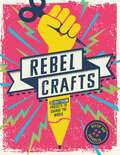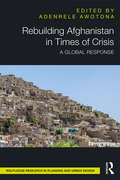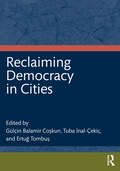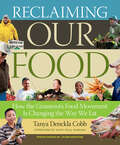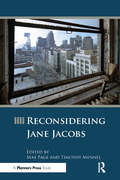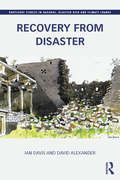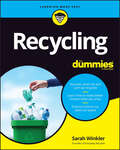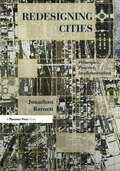- Table View
- List View
Rebel Crafts: 15 Craftivism Projects to Change the World
by Hester Van OverbeekFrom hand-painted signs and stickered slogans to knitted hats and radical badges, craft and protest have always gone together.Combine your passion for making with your desire to make your voice heard with 15 step-by-step craftivism projects. Rebel Crafts is a fun and informative collection of activism-inspired activities created by experienced crafter Hester van Overbeek. Hester will teach you how to screen-print a slogan T-shirt, create bespoke paper for letter-writing campaigns and bring inspiration to your neighbourhood with a handmade mini-library.With your own hands, you can make a difference, resist injustice and spark change in your community. It all starts with craft.
Rebuilding Afghanistan in Times of Crisis: A Global Response
by Adenrele AwotonaRebuilding Afghanistan in Times of Crisis provides academics and researchers interested in planning, urbanism and conflict studies with a multidisciplinary, international assessment of the reconstruction and foreign aid efforts in Afghanistan. The book draws together expert contributions from countries across three continents – Asia, Europe and North America – which have provided external aid to Afghanistan. Using international, regional and local approaches, it highlights the importance of rebuilding sustainable communities in the midst of ongoing uncertainties. It explores the efficacy of external aid; challenges faced; the response of multilateral international agencies; the role of women in the reconstruction process; and community-based natural disaster risk management strategies. Finally, it looks at the lessons learned in the conflict reconstruction process to better prepare the country for future potential human, economic, infrastructural and institutional vulnerabilities.
Rebuilding Afghanistan in Times of Crisis: A Global Response
by Adenrele AwotonaRebuilding Afghanistan in Times of Crisis provides academics and researchers interested in planning, urbanism and conflict studies with a multidisciplinary, international assessment of the reconstruction and foreign aid efforts in Afghanistan. The book draws together expert contributions from countries across three continents – Asia, Europe and North America – which have provided external aid to Afghanistan. Using international, regional and local approaches, it highlights the importance of rebuilding sustainable communities in the midst of ongoing uncertainties. It explores the efficacy of external aid; challenges faced; the response of multilateral international agencies; the role of women in the reconstruction process; and community-based natural disaster risk management strategies. Finally, it looks at the lessons learned in the conflict reconstruction process to better prepare the country for future potential human, economic, infrastructural and institutional vulnerabilities.
Recipes for Urban Happiness: Design for Community Well-being
by Jenny DonovanThe experiences we enjoy, endure, or miss out on are influenced by what our surroundings allow and invite us to do. Just like our food diet, our experience diet influences our health and so our chances of finding happiness and fulfilling our potential. A healthy experience diet offers inspiration, reassurance, delight, and play. It nurtures physical, cognitive, and emotional health, builds resilience, and fosters confidence and self-esteem. An unhealthy experience diet lacks these things and consigns people to lives diminished in quantity and quality. Recipes for Urban Happiness offers an innovative way of looking at the relationship between people and place and redefines what good urban design is. The book outlines what designers and non-designers can do to create urban places where nurturing behaviours are both possible and preferable. Recipes for Urban Happiness will be relevant to public health, community development, and design practitioners, as well as students and academics.
Recipes for Urban Happiness: Design for Community Well-being
by Jenny DonovanThe experiences we enjoy, endure, or miss out on are influenced by what our surroundings allow and invite us to do. Just like our food diet, our experience diet influences our health and so our chances of finding happiness and fulfilling our potential. A healthy experience diet offers inspiration, reassurance, delight, and play. It nurtures physical, cognitive, and emotional health, builds resilience, and fosters confidence and self-esteem. An unhealthy experience diet lacks these things and consigns people to lives diminished in quantity and quality. Recipes for Urban Happiness offers an innovative way of looking at the relationship between people and place and redefines what good urban design is. The book outlines what designers and non-designers can do to create urban places where nurturing behaviours are both possible and preferable. Recipes for Urban Happiness will be relevant to public health, community development, and design practitioners, as well as students and academics.
Reciprocal Landscapes: Stories of Material Movements
by Jane HuttonHow are the far-away, invisible landscapes where materials come from related to the highly visible, urban landscapes where those same materials are installed? Reciprocal Landscapes: Stories of Material Movements traces five everyday landscape construction materials – fertilizer, stone, steel, trees, and wood – from seminal public landscapes in New York City, back to where they came from. Drawing from archival documents, photographs, and field trips, the author brings these two separate landscapes – the material’s source and the urban site where the material ended up – together, exploring themes of unequal ecological exchange, labor, and material flows. Each chapter follows a single material’s movement: guano from Peru that landed in Central Park in the 1860s, granite from Maine that paved Broadway in the 1890s, structural steel from Pittsburgh that restructured Riverside Park in the 1930s, London plane street trees grown on Rikers Island by incarcerated workers that were planted on Seventh Avenue north of Central Park in the 1950s, and the popular tropical hardwood, ipe, from northern Brazil installed in the High Line in the 2000s. Reciprocal Landscapes: Stories of Material Movements considers the social, political, and ecological entanglements of material practice, challenging readers to think of materials not as inert products but as continuous with land and the people that shape them, and to reimagine forms of construction in solidarity with people, other species, and landscapes elsewhere.
Reciprocal Landscapes: Stories of Material Movements
by Jane HuttonHow are the far-away, invisible landscapes where materials come from related to the highly visible, urban landscapes where those same materials are installed? Reciprocal Landscapes: Stories of Material Movements traces five everyday landscape construction materials – fertilizer, stone, steel, trees, and wood – from seminal public landscapes in New York City, back to where they came from. Drawing from archival documents, photographs, and field trips, the author brings these two separate landscapes – the material’s source and the urban site where the material ended up – together, exploring themes of unequal ecological exchange, labor, and material flows. Each chapter follows a single material’s movement: guano from Peru that landed in Central Park in the 1860s, granite from Maine that paved Broadway in the 1890s, structural steel from Pittsburgh that restructured Riverside Park in the 1930s, London plane street trees grown on Rikers Island by incarcerated workers that were planted on Seventh Avenue north of Central Park in the 1950s, and the popular tropical hardwood, ipe, from northern Brazil installed in the High Line in the 2000s. Reciprocal Landscapes: Stories of Material Movements considers the social, political, and ecological entanglements of material practice, challenging readers to think of materials not as inert products but as continuous with land and the people that shape them, and to reimagine forms of construction in solidarity with people, other species, and landscapes elsewhere.
Reclaiming Democracy in Cities
by Gülçin Balamir Coşkun Tuba İnal-Çekiç Ertuğ TombuşEffective urban governance is essential in responding to the challenges of inequality, migration, public health, housing, security, and climate change. Reclaiming Democracy in Cities frames the city as a political actor in its own right, exploring the city’s potential to develop deliberative and participatory practices which help inform innovative democratic solutions to modern day challenges.Bringing together expertise from an international selection of scholars from various fields, this book begins with three chapters which discuss the theoretical idea of the democratic city and the real-world applicability of such a model. Part II discusses new and innovative democratic practices at the local level and asks in what way these practices help us to rethink democratic politics, institutions, and mechanisms in order to move toward a more egalitarian, pluralist, and inclusive direction. Drawing on the Istanbul municipal elections and the Kurdish municipal experience, Part III focuses on the question of whether cities and local governments can lead to the emergence of strong democratic forces that oppose authoritarian regimes. Finally, Part IV discusses urban solidarity networks and collaborations at both the local level and beyond the nation, questioning whether urban solidarity networks and alliances with civil society or transnational city networks can create alternative ways of thinking about the city as a locus of democracy.This edited volume will appeal to academics, researchers, and advanced students in the fields of urban studies, particularly those with an interest in democratic theory; local democracy; participation and municipalities. It will also be relevant for practitioners of local governments, NGOs, and advocacy groups and activists working for solidarity networks between cities.
Reclaiming Democracy in Cities
Effective urban governance is essential in responding to the challenges of inequality, migration, public health, housing, security, and climate change. Reclaiming Democracy in Cities frames the city as a political actor in its own right, exploring the city’s potential to develop deliberative and participatory practices which help inform innovative democratic solutions to modern day challenges.Bringing together expertise from an international selection of scholars from various fields, this book begins with three chapters which discuss the theoretical idea of the democratic city and the real-world applicability of such a model. Part II discusses new and innovative democratic practices at the local level and asks in what way these practices help us to rethink democratic politics, institutions, and mechanisms in order to move toward a more egalitarian, pluralist, and inclusive direction. Drawing on the Istanbul municipal elections and the Kurdish municipal experience, Part III focuses on the question of whether cities and local governments can lead to the emergence of strong democratic forces that oppose authoritarian regimes. Finally, Part IV discusses urban solidarity networks and collaborations at both the local level and beyond the nation, questioning whether urban solidarity networks and alliances with civil society or transnational city networks can create alternative ways of thinking about the city as a locus of democracy.This edited volume will appeal to academics, researchers, and advanced students in the fields of urban studies, particularly those with an interest in democratic theory; local democracy; participation and municipalities. It will also be relevant for practitioners of local governments, NGOs, and advocacy groups and activists working for solidarity networks between cities.
Reclaiming Our Food: How the Grassroots Food Movement Is Changing the Way We Eat
by Tanya Denckla CobbThis book offers sustainable food solutions by sharing the stories of more than 50 groups and individuals across the U.S. who have successfully implemented innovative ideas for increasing the availability of local food.
Reconsidering Jane Jacobs
by Max Page Timothy MennelThis volume begins with the premise that the deepest respect is shown through honest critique. One of the greatest problems in understanding the influence of the author on cities and planning is that she has for much of the past five decades been "Saint Jane, the housewife" who upended urban renewal and gave us back our cities. Over time, she has become a saintly stick figure, a font of simple wisdom for urban health that allows many to recite her ideas and few to understand their complexity. The author has been the victim of her own success. This book gives this important thinker the respect she deserves, reminding planning professionals of the full range and complexity of her ideas and offering thoughtful critiques on the unintended consequences of her ideas on cities and planning today. It also looks at the international relevance – or lack thereof – of her work, with essays on urbanism in Abu Dhabi, Argentina, China, the Netherlands, and elsewhere.
Reconsidering Jane Jacobs
by Max Page Timothy MennelThis volume begins with the premise that the deepest respect is shown through honest critique. One of the greatest problems in understanding the influence of the author on cities and planning is that she has for much of the past five decades been "Saint Jane, the housewife" who upended urban renewal and gave us back our cities. Over time, she has become a saintly stick figure, a font of simple wisdom for urban health that allows many to recite her ideas and few to understand their complexity. The author has been the victim of her own success. This book gives this important thinker the respect she deserves, reminding planning professionals of the full range and complexity of her ideas and offering thoughtful critiques on the unintended consequences of her ideas on cities and planning today. It also looks at the international relevance – or lack thereof – of her work, with essays on urbanism in Abu Dhabi, Argentina, China, the Netherlands, and elsewhere.
Reconstruction and Restoration of Architectural Heritage 2021: Proceedings of 3rd International Conference on Reconstruction and Renovation of Architectural Heritage, March 24-27, 2021, Saint Petersburg, Russia
by Sergey SementsovReconstruction and Restoration of Architectural Heritage 2021 presents contributions on various aspects of the study, protection and restoration of architectural monuments and on the reconstruction of major historical urban development sites. Moreover, various complex and problematic aspects of engineering reconstruction of monuments are discussed. A wide range of issues is considered in the process of preserving historical heritage, including: the historical formation of buildings, construction and territories; the conservation, reconstruction and restoration of buildings and constructions; the transformation of historical spaces and areas. parallels and features in the development of urban planning, architecture and construction art in Russia and Spain the fate and work of Augustine Augustinovich Betancourt This collection of papers combines contributions about the history and restoration of many of the largest nature reserves, estates, cities and monuments. It is intended for academics and professionals involved in the history and restoration of nature reserves, estates, cities and monuments.
Reconstruction and Restoration of Architectural Heritage 2021: Proceedings of 3rd International Conference on Reconstruction and Renovation of Architectural Heritage, March 24-27, 2021, Saint Petersburg, Russia
by Sergey Sementsov Alexander Leontyev Huerta SantiagoReconstruction and Restoration of Architectural Heritage 2021 presents contributions on various aspects of the study, protection and restoration of architectural monuments and on the reconstruction of major historical urban development sites. Moreover, various complex and problematic aspects of engineering reconstruction of monuments are discussed. A wide range of issues is considered in the process of preserving historical heritage, including: the historical formation of buildings, construction and territories; the conservation, reconstruction and restoration of buildings and constructions; the transformation of historical spaces and areas. parallels and features in the development of urban planning, architecture and construction art in Russia and Spain the fate and work of Augustine Augustinovich Betancourt This collection of papers combines contributions about the history and restoration of many of the largest nature reserves, estates, cities and monuments. It is intended for academics and professionals involved in the history and restoration of nature reserves, estates, cities and monuments.
Recovering Caribbean Nature
by James A. Kushlan Kirsten HinesThe Caribbean is a global biodiversity hotspot; half its resident bird species are found nowhere else, yet, a quarter are threatened with extinction. Nearly all its native amphibians and reptiles and thousands of plants also are endemic. Yet, less than 1% of the landscape can be considered natural; and apart from reserves, most land is privately owned. Despite the challenges of such habitat fragmentation, the Caribbean’s distinctive fauna and flora can be preserved through planning and managing a connected network of sustainable naturalistic landscapes, reserves, parks, and private gardens. This book uniquely provides both a theoretical background and practical applications to restoring nature within the tropical Caribbean. Packed with beautiful color photographs, it offers unifying principles that can be applied across the tropics and synthesizes information on the Caribbean's environmental uniqueness and globally significant biodiversity. It also provides explicit guidance on establishing sustainable and more naturalistic landscapes from large public lands to private yards and gardens.The book is essential reading for academics and researchers studying the Caribbean environment, resource management professionals, and scientists and.educatos from nongovernmental organizations who provide programs and advocacy for conservation and regional sustainability. Moreover, it highlights the importance of private lands and gardens, where the greatest gains can be made, and so offers a handbook for knowledgeable private landowners and their professional advisors.
Recovering Caribbean Nature
by James A. Kushlan Kirsten HinesThe Caribbean is a global biodiversity hotspot; half its resident bird species are found nowhere else, yet, a quarter are threatened with extinction. Nearly all its native amphibians and reptiles and thousands of plants also are endemic. Yet, less than 1% of the landscape can be considered natural; and apart from reserves, most land is privately owned. Despite the challenges of such habitat fragmentation, the Caribbean’s distinctive fauna and flora can be preserved through planning and managing a connected network of sustainable naturalistic landscapes, reserves, parks, and private gardens. This book uniquely provides both a theoretical background and practical applications to restoring nature within the tropical Caribbean. Packed with beautiful color photographs, it offers unifying principles that can be applied across the tropics and synthesizes information on the Caribbean's environmental uniqueness and globally significant biodiversity. It also provides explicit guidance on establishing sustainable and more naturalistic landscapes from large public lands to private yards and gardens.The book is essential reading for academics and researchers studying the Caribbean environment, resource management professionals, and scientists and.educatos from nongovernmental organizations who provide programs and advocacy for conservation and regional sustainability. Moreover, it highlights the importance of private lands and gardens, where the greatest gains can be made, and so offers a handbook for knowledgeable private landowners and their professional advisors.
Recovery from Disaster (Routledge Studies in Hazards, Disaster Risk and Climate Change)
by David Alexander Ian DavisDisasters can dominate newspaper headlines and fill our TV screens with relief appeals, but the complex long-term challenge of recovery—providing shelter, rebuilding safe dwellings, restoring livelihoods and shattered lives—generally fails to attract the attention of the public and most agencies. On average 650 disasters occur each year. They affect more than 200 million people and cause $166 trillion of damage. Climate change, population growth and urbanisation are likely to intensify further the impact of natural disasters and add to reconstruction needs. Recovery from Disaster explores the field and provides a concise, comprehensive source of knowledge for academics, planners, architects, engineers, construction managers, relief and development officials and reconstruction planners involved with all sectors of recovery, including shelter and rebuilding. With almost 80 years of first-hand experience of disaster recovery between them, Ian Davis (an architect) and David Alexander (a geographer) draw substantially from first-hand experiences in a variety of recovery situations in China, Haiti, Italy, Japan, New Zealand, Pakistan, the Philippines and the USA. The volume is further enriched by two important and unique features: 21 models of disaster recovery are presented, seven of which were specifically developed for the book. The second feature is a survey of expert opinion about the nature of effective disaster recovery—the first of its kind. More than 50 responses are provided in full, along with an analysis that integrates them with the theories that underpin them. By providing a framework and models for future study and applications, Davis and Alexander seek both to advance the field and to provide a much-needed reference work for decision makers. With a broad perspective derived from the authors' roles held as university professors, researchers, trainers, consultants, NGO directors and advisors to governments and UN agencies, this comprehensive guide will be invaluable for practitioners and students of disaster management.
Recovery from Disaster (Routledge Studies in Hazards, Disaster Risk and Climate Change)
by David Alexander Ian DavisDisasters can dominate newspaper headlines and fill our TV screens with relief appeals, but the complex long-term challenge of recovery—providing shelter, rebuilding safe dwellings, restoring livelihoods and shattered lives—generally fails to attract the attention of the public and most agencies. On average 650 disasters occur each year. They affect more than 200 million people and cause $166 trillion of damage. Climate change, population growth and urbanisation are likely to intensify further the impact of natural disasters and add to reconstruction needs. Recovery from Disaster explores the field and provides a concise, comprehensive source of knowledge for academics, planners, architects, engineers, construction managers, relief and development officials and reconstruction planners involved with all sectors of recovery, including shelter and rebuilding. With almost 80 years of first-hand experience of disaster recovery between them, Ian Davis (an architect) and David Alexander (a geographer) draw substantially from first-hand experiences in a variety of recovery situations in China, Haiti, Italy, Japan, New Zealand, Pakistan, the Philippines and the USA. The volume is further enriched by two important and unique features: 21 models of disaster recovery are presented, seven of which were specifically developed for the book. The second feature is a survey of expert opinion about the nature of effective disaster recovery—the first of its kind. More than 50 responses are provided in full, along with an analysis that integrates them with the theories that underpin them. By providing a framework and models for future study and applications, Davis and Alexander seek both to advance the field and to provide a much-needed reference work for decision makers. With a broad perspective derived from the authors' roles held as university professors, researchers, trainers, consultants, NGO directors and advisors to governments and UN agencies, this comprehensive guide will be invaluable for practitioners and students of disaster management.
Recycling For Dummies
by Sarah WinklerLearn the facts about recycling and discover the best way to make an impact Recycling is a simple action we can take that has an immediate positive effect. It keeps waste out of landfills, conserves natural resources, prevents pollution, and saves energy. Who wouldn’t want to do this? But recycling isn’t always straightforward. With so many different rules, it can be tough to work out the right thing to do. If you’re worried that you’re not recycling properly, or wondering whether you could be recycling more, this is the book for you. Recycling For Dummies cuts through the confusion around what you can and can’t recycle. This easy-to-follow manual breaks down recycling codes, symbols, and rules in a straightforward way that anyone can understand and apply. You’ll gain insight into the recycling process (where does that stuff go, anyway?) and learn tons of tips on reusing items in your daily life to cut down on waste. It also guides you on how to make smarter choices as a consumer to help preserve the planet for generations to come. Figure out what common materials can and can’t be recycled Understand what the recycling symbols are telling you Explore the many specialist recycling services available Learn what happens to your recyclables after they get picked up Become a true recycler by switching to recycled productsCheck out this book if you want to make your efforts count and be part of the recycling solution.
Recycling For Dummies
by Sarah WinklerLearn the facts about recycling and discover the best way to make an impact Recycling is a simple action we can take that has an immediate positive effect. It keeps waste out of landfills, conserves natural resources, prevents pollution, and saves energy. Who wouldn’t want to do this? But recycling isn’t always straightforward. With so many different rules, it can be tough to work out the right thing to do. If you’re worried that you’re not recycling properly, or wondering whether you could be recycling more, this is the book for you. Recycling For Dummies cuts through the confusion around what you can and can’t recycle. This easy-to-follow manual breaks down recycling codes, symbols, and rules in a straightforward way that anyone can understand and apply. You’ll gain insight into the recycling process (where does that stuff go, anyway?) and learn tons of tips on reusing items in your daily life to cut down on waste. It also guides you on how to make smarter choices as a consumer to help preserve the planet for generations to come. Figure out what common materials can and can’t be recycled Understand what the recycling symbols are telling you Explore the many specialist recycling services available Learn what happens to your recyclables after they get picked up Become a true recycler by switching to recycled productsCheck out this book if you want to make your efforts count and be part of the recycling solution.
Redesigning Cities: Principles, Practice, Implementation
by Jonathan BarnettThis book is recommended reading for planners preparing to take the AICP exam. Too often, no one is happy with new development: Public officials must choose among unappealing alternatives, developers are frustrated and the public is angry. But growing political support for urban design, developers' interest in community building and successful examples of redesigned cities all over the U.S. are hopeful signs of change. The author explains how design can reshape suburban growth patterns, revitalize older cities, and retrofit metropolitan areas where earlier development decisions went wrong. The author describes in detail specific techniques, materials, and technologies that should be known (but often aren't) to planners, public officials, concerned citizens, and others involved in development.
Redesigning Cities: Principles, Practice, Implementation
by Jonathan BarnettThis book is recommended reading for planners preparing to take the AICP exam. Too often, no one is happy with new development: Public officials must choose among unappealing alternatives, developers are frustrated and the public is angry. But growing political support for urban design, developers' interest in community building and successful examples of redesigned cities all over the U.S. are hopeful signs of change. The author explains how design can reshape suburban growth patterns, revitalize older cities, and retrofit metropolitan areas where earlier development decisions went wrong. The author describes in detail specific techniques, materials, and technologies that should be known (but often aren't) to planners, public officials, concerned citizens, and others involved in development.
Rediscovering the Great Plains: Journeys by Dog, Canoe, and Horse (Creating the North American Landscape)
by Norman Scott HendersonThe North American Plains are one of the world's great landscapes—perhaps the signature landscape of the continent. Today, the most intimate experience most of us have of the great grasslands is from behind the window of a car or train. It was not always so. In the earliest days, Plains Indians traveled on foot across the vastness, with only the fierce, wolflike Plains dogs as companions. Later, with the arrival of the Europeans, horses and canoes appeared on the Plains. In Rediscovering the Great Plains, Norman Henderson, a leading scholar of the world's great temperate grasslands, revives these traditional modes of travel, journeying along 200 miles of Canada's Qu'Appelle River valley by dog and travois (the wooden rack pulled by dogs and horses used by Native Americans to transport goods), then by canoe, and finally by horse and travois.Henderson interweaves his own adventures with the exploits of earlier Plains travelers, like Lewis and Clark, Francisco Coronado, La Vérendrye, and Alexander Henry. Lesser-known experiences of the fur traders and others who struggled to cross this strange and forbidding landscape also illuminate the story, while Henderson's often humorous description of his attempts to find and train old Plains breeds of dogs and horses highlight the difficulties involved in recreating archaic travel methods. He also draws on the history of the world's other great temperate grasslands: the South American pampas and the Eurasian steppes. Recalling the work of Ian Frazier and Jonathan Raban, Henderson's captivating account of his three journeys of exploration will foster a better appreciation for, and deeper understanding of, the natural and human history of the North American Plains.
Rediscovery of Cultural Landscapes in Southern China: Sustainable Heritage and Planning in Rural Settlements (Planning, Heritage and Sustainability)
by Wallace P.H. ChangThis book investigates the concept of human landscape in rural settlements in Southern China, where communities and their cultural landscapes are facing contemporary challenges following a period of rapid urbanization in the last 50 years. While metropolitan cities, such as Hong Kong, are experiencing accelerated urban development, underpopulated rural villages are struggling to maintain the cultural heritage of their regions. Rediscovery of Cultural Landscapes in Southern China provides a detailed account into indigenous living cultures in traditional, rural settlements upon natural landscapes. Beginning with an overview of the theoretical framework, the book presents six unique cases, including: Tai O, Yim Tin Tsai, Lai Chi Wo, Nga Tsin Wai, Cangdong, and Meinong, while illustrating a relevant comparison between Hakka and Satoyama landscape systems. The spectrum of theoretical and case analyses allows for a rethinking of the evolving cultural landscape’s positioning with valuable heritages in the context of a post-industrial society. The book is written towards reinterpreting the cultural landscape by conceptualizing the human landscape for scholars, practitioners, and students interested in rural-cultural conservation and revitalization, heritage management, traditional architecture and landscape planning, and urban-rural development.
Rediscovery of Cultural Landscapes in Southern China: Sustainable Heritage and Planning in Rural Settlements (Planning, Heritage and Sustainability)
by Wallace P.H. ChangThis book investigates the concept of human landscape in rural settlements in Southern China, where communities and their cultural landscapes are facing contemporary challenges following a period of rapid urbanization in the last 50 years. While metropolitan cities, such as Hong Kong, are experiencing accelerated urban development, underpopulated rural villages are struggling to maintain the cultural heritage of their regions. Rediscovery of Cultural Landscapes in Southern China provides a detailed account into indigenous living cultures in traditional, rural settlements upon natural landscapes. Beginning with an overview of the theoretical framework, the book presents six unique cases, including: Tai O, Yim Tin Tsai, Lai Chi Wo, Nga Tsin Wai, Cangdong, and Meinong, while illustrating a relevant comparison between Hakka and Satoyama landscape systems. The spectrum of theoretical and case analyses allows for a rethinking of the evolving cultural landscape’s positioning with valuable heritages in the context of a post-industrial society. The book is written towards reinterpreting the cultural landscape by conceptualizing the human landscape for scholars, practitioners, and students interested in rural-cultural conservation and revitalization, heritage management, traditional architecture and landscape planning, and urban-rural development.
